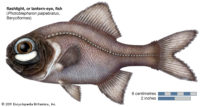
Flashlight fish are a stunning family of predominantly deep-sea fish that are named for a pair of relatively large bioluminescent organs that lie beneath their eyes. The fish themselves are not directly bioluminescent, but their sub-ocular organs are full of light-producing bacteria that the fish can expose or hide using a lid or pouch. This allows them to produce a flashing effect that they can use to escape prey and locate food. The fish grow these bacteria and even dedicate extra resources to making them healthier, and thus brighter, creating a very unique symbiosis. That said, not much about them is known.
Recently, Dr. David Gruber and Brennan Phillips (two great friends of the Pierce Lab) came across a large group of flashlight fish exhibiting never-before-seen schooling behaviors, and they were immediately in awe.
Gruber and Phillips, alongside Dr. Vincent Pieribone and colleagues from his lab (Dr. Ganesh Vasan, Peter O’Brien, and intern Rory O’Brien), as well as scholars from Rice University and the American Museum of Natural History, had their paper published today in PLOS One. They describe the schooling behavior of these fish and discuss how and why they might use such a unique mechanism in one of the least forgiving environments on the planet, the deep sea.

